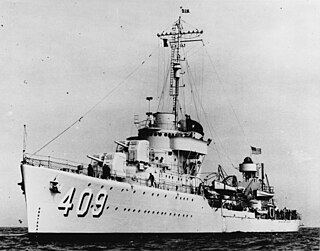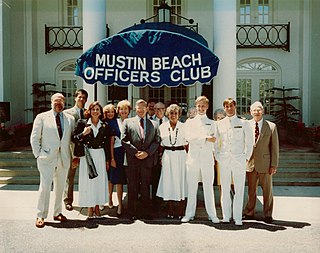USS Mustin may refer to:
- USS Mustin (DD-413), was a Sims-class destroyer during World War II
- USS Mustin (DDG-89), is an Arleigh Burke-class guided missile destroyer currently in active service
USS Mustin may refer to:
USS Cole is the name of two ships of the United States Navy;
USS Farragut may refer to the following ships of the United States Navy:

USS Mustin (DD-413) was a Sims-class destroyer of the United States Navy, the first Navy ship of that name, in honor of Captain Henry C. Mustin (1874–1923), a pioneer of naval aviation.

USS Mustin (DDG-89) is an Arleigh Burke-class guided missile destroyer in the United States Navy. She is named in honor of the Mustin family who has devoted over a century of U.S. Naval service. This ship is the 39th destroyer of her class. USS Mustin was the 18th ship of this class to be built at Ingalls Shipbuilding in Pascagoula, Mississippi, and construction began on 15 January 2001. She was launched on 12 December 2001 and was christened on 15 December 2001. On 26 July 2003, a twilight commissioning ceremony was held at the Naval Air Station North Island in San Diego, California.

A guided-missile destroyer is designed to launch anti-aircraft guided missiles. Many are also equipped to carry out anti-submarine, anti-air, and anti-surface operations. The NATO standard designation for these vessels is DDG. Nations vary in their use of destroyer D designation in their hull pennant numbering, either prefixing or dropping it altogether. The U.S. Navy has adopted the classification DDG in the American hull classification system.
USS Dale may refer to:
USS Cummings has been the name of more than one United States Navy ship, and may refer to:

The Sims-class destroyers were built for the United States Navy, and commissioned in 1939 and 1940. These twelve ships were the last United States destroyer class completed prior to the American entry into World War II. All Sims-class ships saw action in World War II, and seven survived the war. No ship of this class saw service after 1946. They were built under the Second London Naval Treaty, in which the limit on destroyer standard displacement was lifted, but an overall limit remained. Thus, to maximize the number of destroyers and avoid developing an all-new design, the Sims class were only 70 tons larger as designed than previous destroyers. They are usually grouped with the 1500-ton classes and were the sixth destroyer class since production resumed with the Farragut class in 1932.
USS Kidd may refer to:
USS Preble may refer to:
USS Cushing may refer to one of several United States Navy ships named in honor of William B. Cushing:
Four ships of the United States Navy have borne the name USS Hull, in honor of Commodore Isaac Hull.
USS Turner may refer to:
USS Percival may refer to:

Henry Croskey Mustin was a pioneering naval aviator who undertook the task of establishing the first Naval Aeronautic Station on the site of the abandoned Navy Yard at Warrington, Florida in 1914. He was designated Navy Air Pilot No. 3 and later Naval Aviator No. 11. Two U.S. Navy destroyers have borne the name Mustin in honor of Captain Mustin and his descendants, three of whom have served as flag officers.

Destroyer Squadron 15 is a squadron of United States Navy Arleigh Burke-class destroyers based at Yokosuka, Japan.

Lloyd Montague Mustin was a vice admiral in the United States Navy and among the namesakes of USS Mustin (DDG-89). He took part in developing the Navy's first lead-computing anti-aircraft gun sight, which proved of major importance in the air-sea actions of World War II, and he served on the cruiser USS Atlanta during the naval battle of Guadalcanal. His ship was lost during that action, and with other survivors he landed on Guadalcanal and served ashore with a naval unit attached to the First Marine Division. His postwar service included commands at sea and development and evaluation of weapon systems. He later served as director of operations for the Joint Chiefs of Staff during the Vietnam War.

The Mustin family has recorded a tradition of service in the United States Navy extending from 1896 to the present. Their naval roots trace back to Commodore Arthur Sinclair. Probably the most famous member was Henry Croskey Mustin, a pioneering naval aviator who was designated Navy Air Pilot No. 3 and later Naval Aviator No. 11. Two U.S. Navy destroyers have borne the name Mustin in honor of members of the family, U.S. Navy destroyer USS Mustin (DD-413) and the U.S. Navy guided-missile destroyer USS Mustin (DDG-89).

Henry "Hank" Croskey Mustin was a vice admiral in the United States Navy and among the namesakes of USS Mustin (DDG-89). He distinguished himself during both the Vietnam and Cold Wars. As a flag officer he commanded Cruiser Destroyer Group 2, US Second Fleet, NATO Striking Fleet Atlantic, and Joint Task Force 120, where he was responsible for 225 ships and 2,100 aircraft spanning over 45 million square miles from the Arctic Circle to the Equator. Vice Admiral Mustin directed US Navy arms control planning, including the START negotiations with the Soviet Union. He led high-level US interagency delegations to Moscow, London, Paris, Lisbon, Oslo and Seoul. As Commander, NATO Striking Fleet Atlantic, he instituted major strategic changes to the defense of NATO that shaped the nation's maritime strategy. He also served as the senior US military representative to the United Nations. He retired from the navy on January 1, 1989, after nearly 34 years of active duty service.
Henry C. Mustin may refer to: